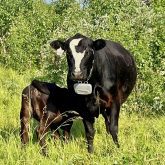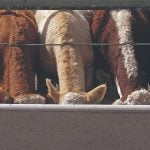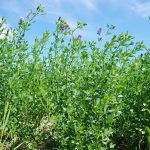The 2020s did come in with a roar, but not the kind people hoped for, as drought has plagued much of Western Canada since 2021.
The pastures were dry across the Prairies, the grass brittle, more brown than green. Dugouts ran dry and in some areas, hay production was about a quarter of normal. Water is the most important nutrient for farmers, and in 2021, it was scarce.
In many areas, this has persisted into 2024 and beyond.
Read Also

The Canadian Cattle Association’s international advocacy efforts
Global ag policies affect Canadian food policy, so the Canadian Cattle Association participates in international and domestic forums
Some beef producers downsized their herds. Others exited the industry.
Native grass holds up
Stuart Somerville lives near Endiang, Alta., where he ranches with his parents, his wife and his children. He is the fourth generation to work on the farm, where they run about 350 head of cattle.
But since 2021, they have been struggling with drought.
“I’m not convinced it’s ever going to end. Our normal conditions may be drought,” Somerville says.
They have been dealing with many challenges as the drought continues. Somerville says there hasn’t been much surface water for a couple of years. As a result, their grass quality has degraded. While they have grass in the spring, by the summer it is often not doing well.
Their native pastures have been helping them continue to graze through the summer.
“What rain we had came at a good time for it (native grass). But it was just terrible for tame grass.”
His main concern, though, is with water availability. Sometimes, the only available water is in their most remote pastures, which means it dictates their grazing schedule. Sometimes there is little shelter in those pastures and the grass isn’t the best, but it is necessary to use it as water becomes most important.
“We end up moving cattle sometimes when we’re not quite ready to. The feed is still there, but we need water more than they need the tastiest grass around.”
Despite these challenges, the Somervilles have been able to maintain their herd size, though that has not been without issues
“Over the past several years we’ve purchased an awful lot of feed. Some years there’s been government assistance sometimes for that, but not throughout.”
Paradigm shift
At the Western Canada Conference of Soil Health and Grazing, which took place in Edmonton, Alta., in December 2024, different producers sat on panels to discuss their grazing habits and how they focus on soil. Something that came up for almost all of them, though, was the effect of drought.
For Rick Stephens, a producer from Bulkley Valley, B.C., drought has been a challenge since 2022.
Stephens owns and operates 6S Family Farm, where he and his family raise cattle and other livestock. They started their operation 10 years ago, and ever since then, they have been working on sustainable and regenerative ranching, focusing on grass.
However, the drought they experienced in 2022 devastated their grass production.
“Looking through our photos, we noticed that we actually didn’t take many photos of the grass for the last few years, because it was so depressing,” Stephens says. “That’s one thing you don’t necessarily think about as an effect of drought, but mentally, things start to feel oppressive and bleak.”
Stephens says they decided to destock by selling the calves in August to save as much grass as possible. The cows they kept they sent to a friend, where they were fed a ration containing a high proportion of molasses. They bought calves and put them in a feedlot to help with cash flow.
“We found that sell-buy marketing can be quite profitable and doesn’t require a great deal of time. It was a paradigm shift for us.”
They ran into other issues with the drought, the most prevalent being water hemlock. Water hemlock grows when swampy areas dry up and is poisonous. Stephens didn’t realize he had it on his operation until 10 per cent of the cattle he had on that pasture died.
“As we found out, it can decrease your herd numbers in a very short period of time.”
They also had to deal with wildfires near their place. So they changed their grazing management by increasing recovery time for each paddock, giving some pieces of land whole seasons to recover. While this was a challenge at the time, Stephens hopes once they see the end of the drought, they will also see a payoff when the grass bounces back.
Drought history
The last widespread drought in the Prairies was in the early 2000s. Since then, it’s been a mix of wet and dry years. As of the end of November 2024, 51 per cent of Canada was classified as abnormally dry or in moderate or extreme drought, with the most significant areas for drought being in central Alberta, northern Alberta and British Columbia, bordering the Northwest Territories.
Barrie Bonsal, a research scientist with the federal government, says the most recent drought was preceded by a wet period.
“Maybe starting in 2010 for about five years … it was a little bit wetter than normal, if you look at the data.” When you go into a drought after a wet cycle, it likely “hits you a bit harder,” he says.
While some areas had drought before 2021 and other areas have had persistent drought, Bonsal says 2021 was by far the driest year in the current dry stretch.
Drought comes in cycles — notable ones being in the 1930s, the ’80s, and again in the early 2000s. Weather events, such as a persistent high-pressure system, cause droughts. “It has to do with the jet stream. It is often referred to as a block where it doesn’t allow any moisture in, and that generally initiates some of the drought,” Bonsal says.
However, he expects drought may become more common because of the changing climate.
“With the warming temperatures, we’re getting spring coming a little bit earlier, fall a little bit later, on average. So you’re having a longer summer season and you have less ice and snow, and more open water. You can get more evaporation from that longer season as well.”
Bonsal says climate models predict when rain does come, it will be in more extreme events, which means there will be longer gaps between precipitation events.
“We have to be aware that the droughts might be a little bit different than what we’ve seen in the past.”
Moving forward
Both Somerville and Stephens are looking to the future, despite the hardships they have endured. In Stephens’s part of the country, he is expecting the drought to end soon — already they had had more snowfall by December 2024 than in the past two years. He says he is excited for their grass to bounce back.
“We’re excited to see how resilient our pastures have become thanks to the wealth of information we learned and put into practice from mentors and people within the regenerative ag community.”
Somerville, however, does not think they’ve seen the end of the drought in his area. He thinks drought might become the new norm — one they will have to adapt to. He says they are planning on using more electric fence and solar pumping systems to draw from the groundwater.
“We can’t change how grass grows very much. We can adapt how we manage it and graze it a little bit, but the grass still needs water to fall.”
The ranch has been in Somerville’s family for four generations and has withstood many hardships. Somerville says he is committed to seeing it through this challenge, just like his ancestors did.
“I don’t think they ever knew exactly how they were going to get through it, but somehow they did. And maybe we’ll have the same luck they did, and we’ll find a way through it.”

















